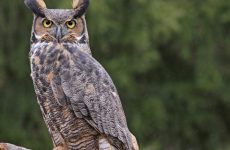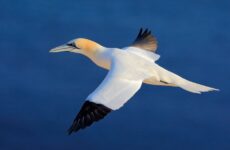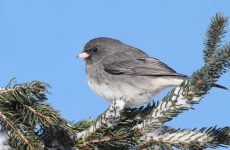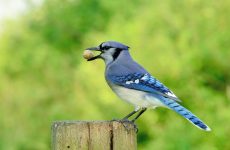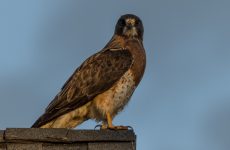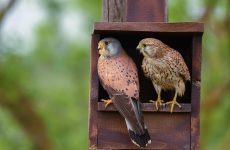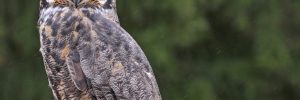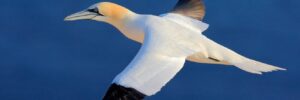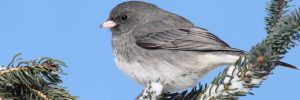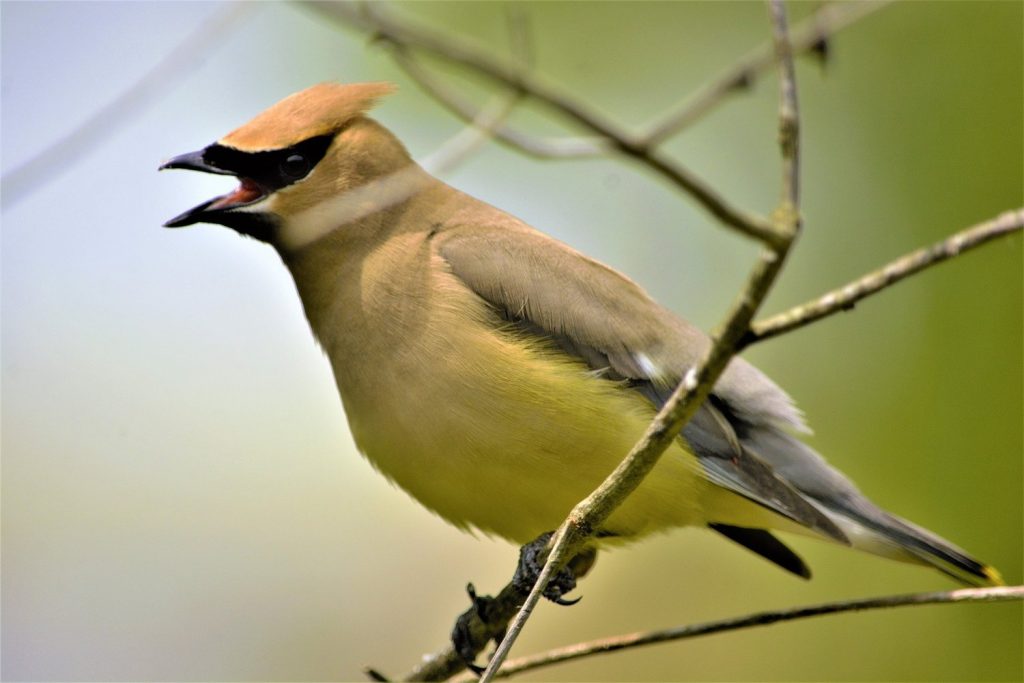
Yellow birds are common in Nova Scotia in spring and summer when the warblers arrive, but in winter, only the American Goldfinch is a commonly spotted yellow bird here.
This guide will help you identify yellow birds in Nova Scotia that you have spotted by giving you pictures, identification information, song recordings, and when they migrate in and out.
Most yellow birds in Nova Scotia are warblers, finches, or orioles, and sometimes they are female birds that look very different from the male of their species.
Identifying yellow birds will be a lot easier with all the information in this guide. I have listed these yellow birds in the order of which are most commonly spotted in Nova Scotia according to ebird checklists in spring and summer (May and June).
Yellow birds in Nova Scotia all year: American Goldfinch, Evening Grosbeak, Eastern Meadowlark
Yellow birds in Nova Scotia in summer: Yellow-rumped Warbler, Common Yellowthroat, Yellow Warbler, Cedar Waxwing, American Redstart, Black-throated Green Warbler, Magnolia Warbler, Palm Warbler, Nashville Warbler, Canada Warbler
Yellow birds in Nova Scotia during migration: Baltimore Oriole, Wilson’s Warbler, Cape May Warbler, Orange-crowned Warbler
So read on to identify those yellow birds you have spotted.
17 Yellow Birds In Nova Scotia:
1. American Goldfinch
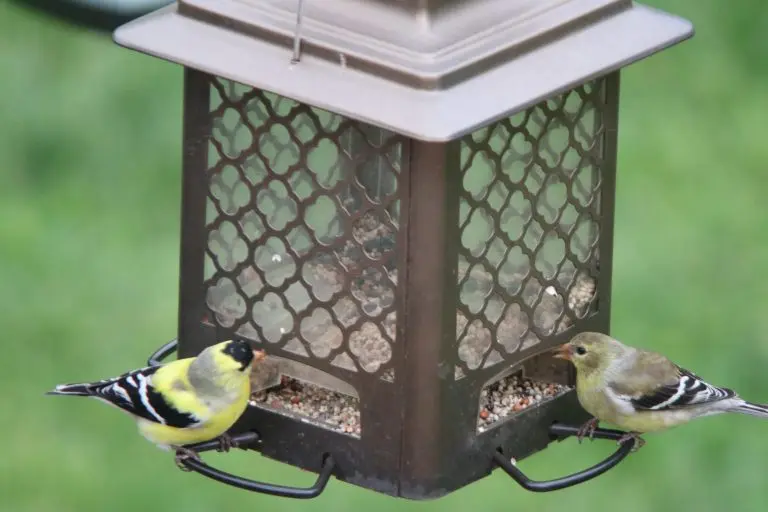
American Goldfinches are spotted all year in Nova Scotia, but their numbers increase during the breeding season from April to September. They are recorded in 49% of summer checklists and 31% of winter checklists submitted by bird watchers for the province.
American Goldfinches are popular birds. The males have bright yellow and black coloring in spring. The females are duller brown, as are males in winter.
- Spinus tristis
- Length: 4.3-5.1 in (11-13 cm)
- Weight: 0.4-0.7 oz (11-20 g)
- Wingspan: 7.5-8.7 in (19-22 cm)
American Goldfinches can be found in most of North America and are usually resident all year. However, those that breed in Canada and the Midwest migrate to the southern US States for winter.
You can find American Goldfinch in weedy fields and overgrown areas foraging for sunflower, thistle, and aster plants. They are also common in suburbs, parks, and backyards.
American Goldfinch Song:
Nests of American Goldfinches are usually located in saplings or shrubs. They are made of grass, bark strips, and feathers on which the female lays four to six eggs. It takes ten to twelve days for the eggs to hatch, and while the male feeds the female, she incubates the eggs.
Attract American Goldfinches to your backyard by planting thistles and milkweed. They will visit most bird feeders and prefer sunflower seed and nyjer seed.
Fun Fact: Brown-headed Cowbirds are known for laying eggs in an American Goldfinch nest, but unfortunately, the seed-based diet that the parents feed them is unsuitable for them, and they eventually die.
2. Yellow-rumped Warbler
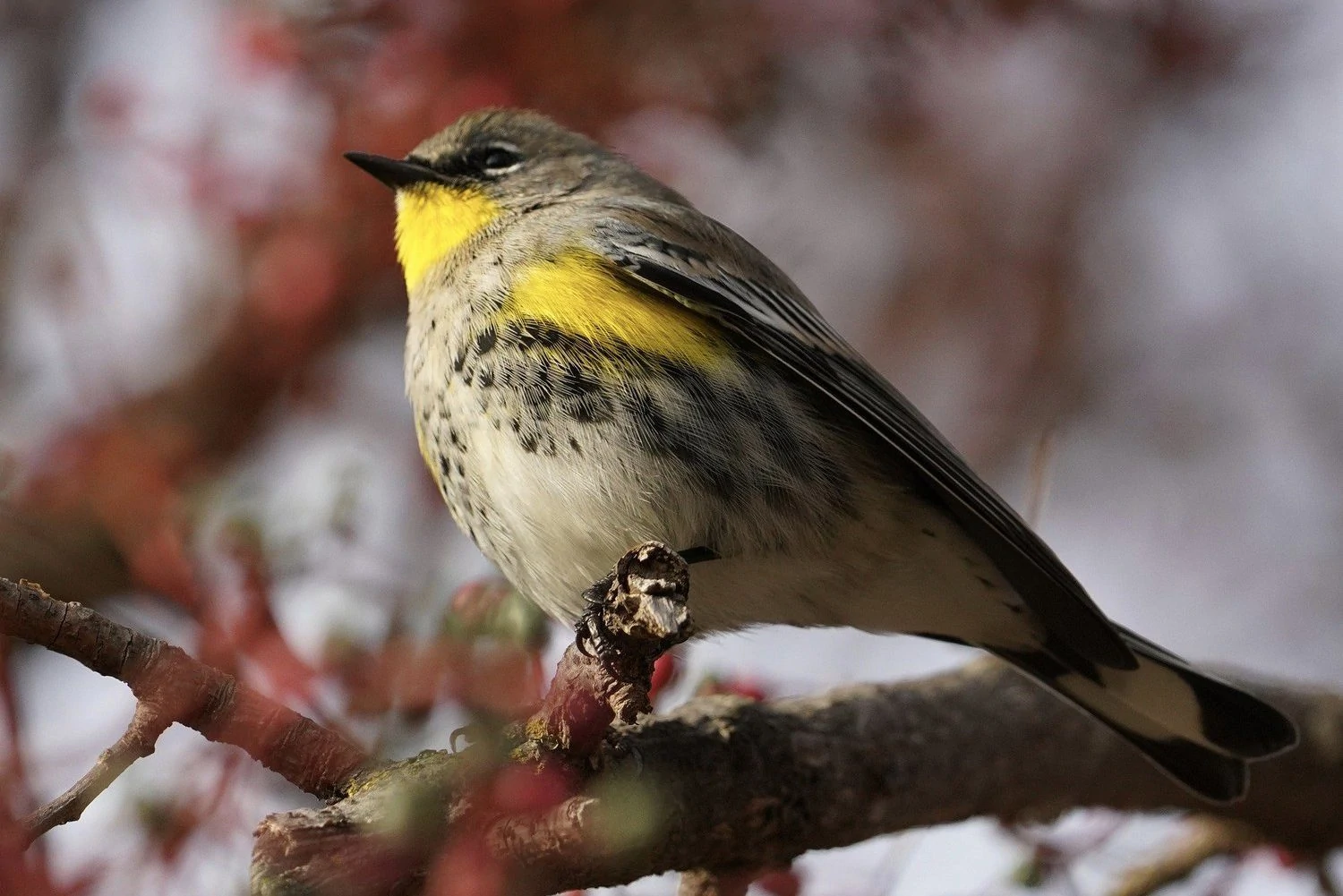
Yellow-rumped Warblers can be spotted during the breeding season in Nova Scotia, but their numbers increase during migration from May to June and from September to October. They are recorded in 26% of summer checklists and up to 41% of checklists during migrations.
Yellow-rumped Warblers are gray with flashes of yellow on the face, sides, and rump and white in the wings.
Females may be slightly brown, and winter birds are paler brown with bright yellow rumps and sides turning bright yellow and gray again in spring.
- Setophaga coronata
- Length: 4.7-5.5 in (12-14 cm)
- Weight: 0.4-0.5 oz (12-13 g)
- Wingspan: 7.5-9.1 in (19-23 cm)
Yellow-rumped Warblers breed predominantly in Canada and parts of the Rockies and the Appalachian mountains.
They can be seen in the Midwest during migration before overwintering in southern and southwestern US states and the Pacific Coast, and into Mexico and Central America.
You can find Yellow-rumped Warblers in coniferous forests, especially during the breeding season. During winter, they can be found in open areas with fruiting shrubs. In summer, they eat mostly insects and on migration, and in winter, they eat mostly fruit, including bayberry and wax myrtle.
Yellow-rumped Warbler Song:
Nests of Yellow-rumped Warblers are made by females in conifer trees from twigs, pine needles, and grass and lined with soft grass, moss, and hair. They lay up to six eggs which take around two weeks to hatch and a further two weeks to leave the nest.
Attract Yellow-rumped Warblers to your backyard with sunflower seeds, suet, raisins, and peanut butter.
Fun Fact: Yellow-rumped Warblers form flocks numbering thousands in the winter, and they can be aggressive to any other species getting too close.
3. Common Yellowthroat
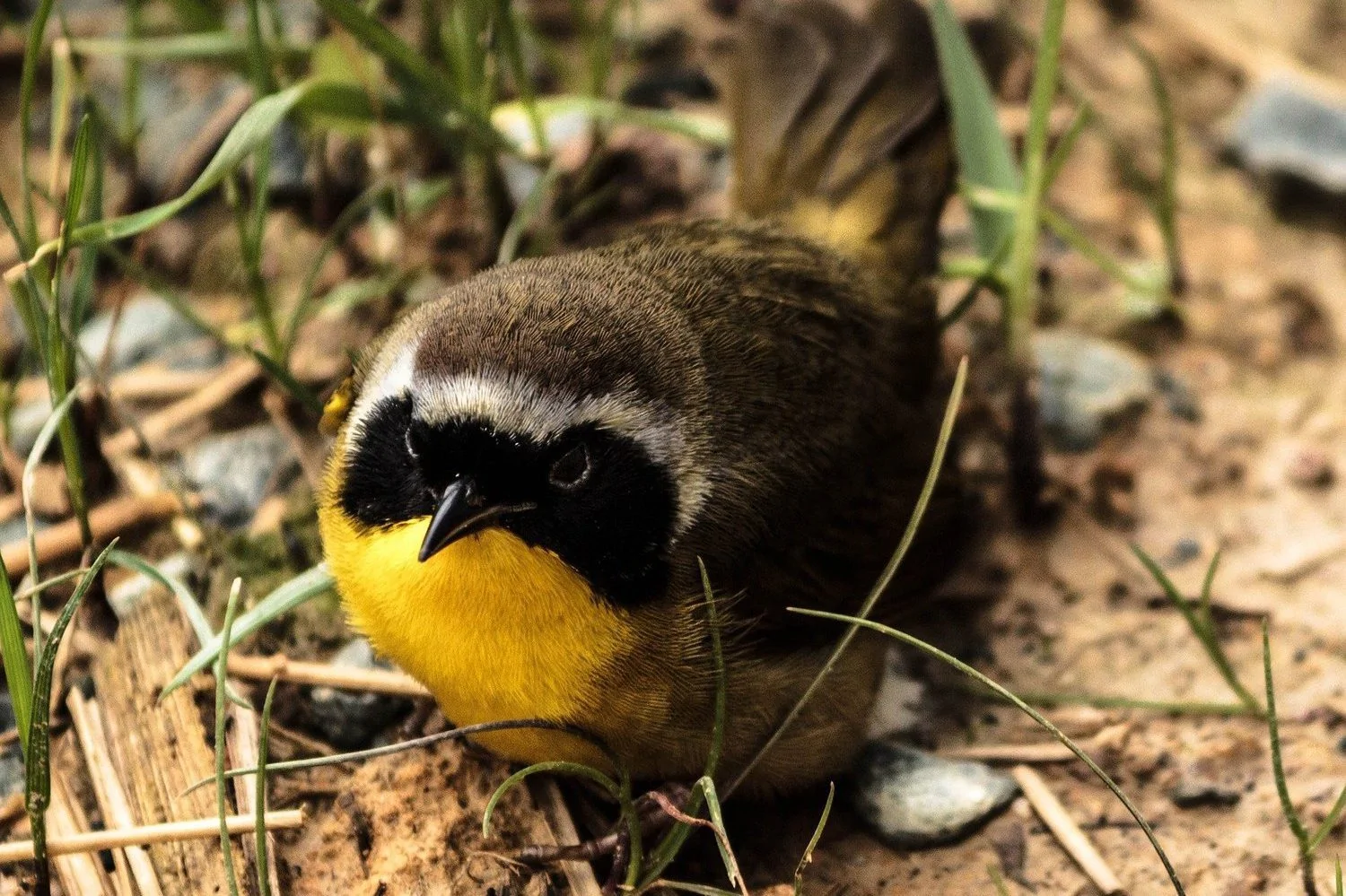
Common Yellowthroats spend the breeding season in Nova Scotia and appear in 27% of summer checklists. They arrive in April and start to migrate in October.
Common Yellowthroats are small songbirds that are brownish on the back and bright yellow underneath, with long tails. The males have black masks across their faces. The brightness of the yellow can vary geographically, and they may be more olive in parts underneath.
- Geothlypis trichas
- Length: 4.3-5.1 in (11-13 cm)
- Weight: 0.3-0.3 oz (9-10 g)
- Wingspan: 5.9-7.5 in (15-19 cm)
Common Yellowthroats spend the summer breeding over most of North America, except Alaska and northern Canada. Some remain all year along the Gulf Coast and Pacific Southwest. Then, they migrate south for winter.
You can find Common Yellowthroats often in marshy or wetland areas and brushy fields living in thick, tangled vegetation.
Common Yellowthroat Song:
Nests of Common Yellowthroats are built by females near the ground in marshy areas and supported by reeds. The nest is made from grass and sedges supported on a platform of leaves and grass. They lay up to six eggs which take around twelve days to hatch and the same for the young to leave the nest.
Attract Common Yellowthroats to large backyards with dense vegetation and native plants to attract insects.
Fun Fact: The black mask of Common Yellowthroats is a sign to courting males that that bird is male, and they attack when fake birds are used, but they do not attack when the bird has no mask.
4. Yellow Warbler
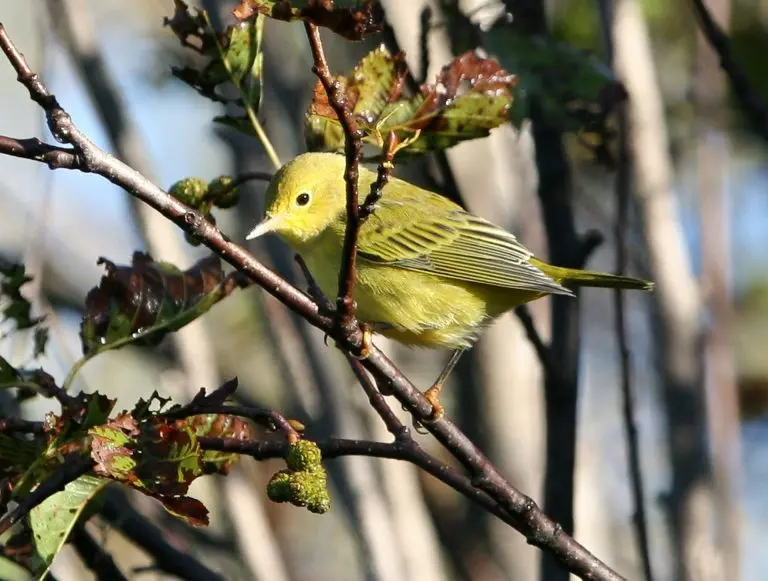
Yellow Warblers are the second most frequently spotted yellow birds in Nova Scotia during the breeding season and occur in 27% of summer checklists. They are mainly seen here from April to September, but a few hang around until December.
Yellow Warblers are small bright yellow birds with a yellow-green back, and the males have chestnut streaks on the breast. Females and juveniles are not as bright as males.
- Setophaga petechia
- Length: 4.7-5.1 in (12-13 cm)
- Weight: 0.3-0.4 oz (9-11 g)
- Wingspan: 6.3-7.9 in (16-20 cm)
Yellow Warblers migrate a long distance to breed in Canada and the US, except for southeastern states, before heading back into Central and South America for winter. However, they can be seen during migration in southeastern US states.
You can find Yellow Warblers along streams and wetlands in thickets and along the edges of fields foraging for insects, including caterpillars, midges, beetles, bugs, and wasps.
Yellow Warbler Song:
Nests of Yellow Warblers are in small trees or shrubs and made from bark, grass, and plant material woven together and secured with spider webs to form a cup. It is then lined with softer material such as hair, feathers, and plant down.
They lay up to seven eggs which take around twelve days to hatch and a further ten days for the young to leave the nest.
Attract Yellow Warblers to your backyard with suet, oranges, peanut butter, and plants with berries. Also, plant native plants that attract insects without pesticides or being too tidy! Also, try birdbaths with fountains near secluded planting to provide protection.
Fun Fact: Cowbirds often lay their eggs in Yellow Warblers’ nests, and if detected, then the Yellow Warblers build a new nest on top of the old nest and eggs and start again – up to six times!
5. Cedar Waxwing
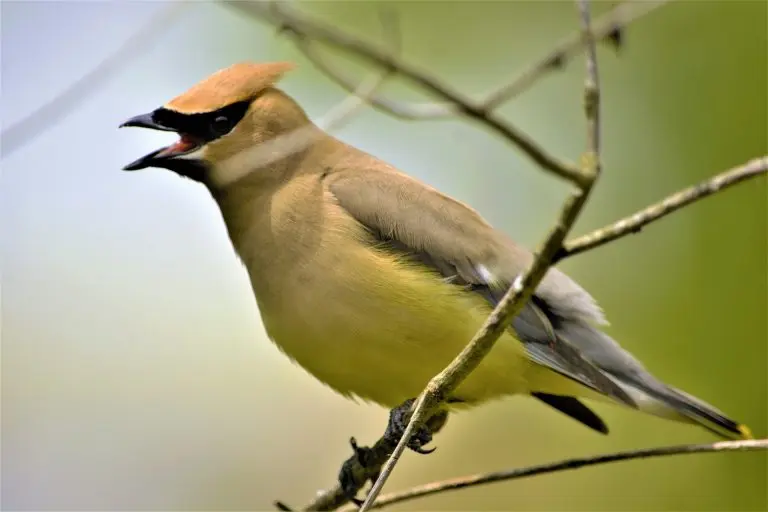
Cedar Waxwings are commonly seen in Nova Scotia during the breeding season and are usually spotted from June to October, but some remain all year. They are recorded in 14% of summer checklists and 1% of winter checklists.
Cedar Waxwings are elegant social birds that are pale brown on the head, chest, and crest, which fades to gray on the back and wings, and tail. Their belly is pale yellow, and there is bright yellow on the tip. They have a narrow black mask over their eyes and bright red on the wingtips.
- Bombycilla cedrorum
- Length: 5.5-6.7 in (14-17 cm)
- Weight: 1.1 oz (32 g)
- Wingspan: 8.7-11.8 in (22-30 cm)
Cedar Waxwings breed in Canada before heading to the southern US, Mexico, and Central America for winter. They are resident all year in northern US states.
You can find Cedar Waxwings in berry bushes, woodlands, grassland, in towns, and along streams. They feed mainly on fruit but also eat insects in summer.
Cedar Waxwing Call:
Nests of Cedar Waxwing are in trees from twigs, grass, hair, and plant material and lined with pine needles and soft grass. They lay up to six eggs which take around twelve days to hatch and a further sixteen or so days for the young to leave the nest.
Attract Cedar Waxwings to your backyard by planting native trees and shrubs that have small fruit, such as serviceberry, dogwood, juniper, winterberry, and hawthorn. You can also try fruit on platform feeders.
Fun Fact: Cedar Waxwings give gifts when courting a potential mate, which they pass between them.
6. American Redstart Female
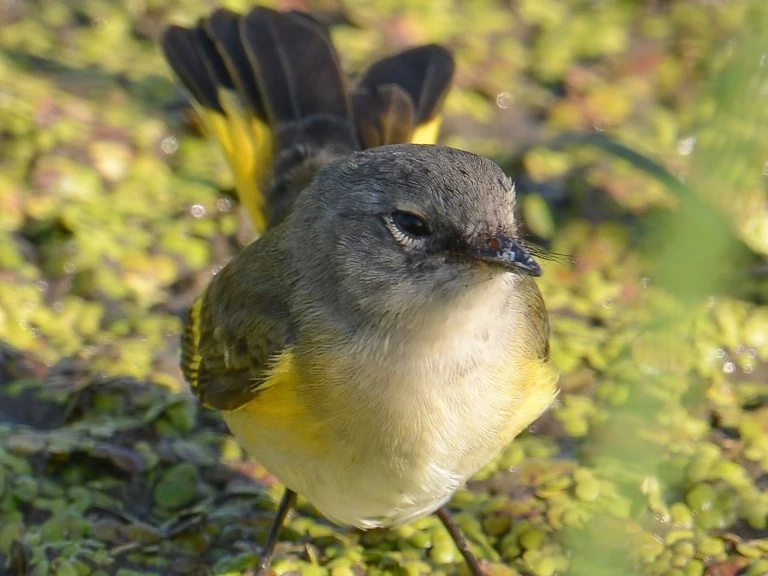
American Redstarts spend the summer in Nova Scotia and occur in 18% of checklists at this time. They are usually spotted from May to October, and a few stay until December.
Male American Redstarts are mostly black with bright orange patches and a white belly. Females are olive-gray instead of black and have lots of yellow patches.
- Setophaga ruticilla
- Length: 4.3-5.1 in (11-13 cm)
- Weight: 0.2-0.3 oz (6-9 g)
- Wingspan: 6.3-7.5 in (16-19 cm)
American Redstarts breed in eastern US states and Canada and into northwestern US states. They may also be seen during migration in central and western US states.
You can find American Redstarts in deciduous woodlands eating insects and also in backyards and thickets eating berries such as serviceberry and magnolia.
American Redstart song: Their song drops in pitch at the end.
Nests of American Redstarts are close to the trunk in trees or large shrubs and are made from bark, grass, and other plant material. They lay up to five eggs which take just under two weeks to hatch and a week or two for the young to leave the nest.
Attract American Redstarts to your backyard with berry plants such as magnolia and serviceberry.
Fun Fact: American Redstart parents only feed certain chicks each rather than feeding them all.
7. Black-throated Green Warbler
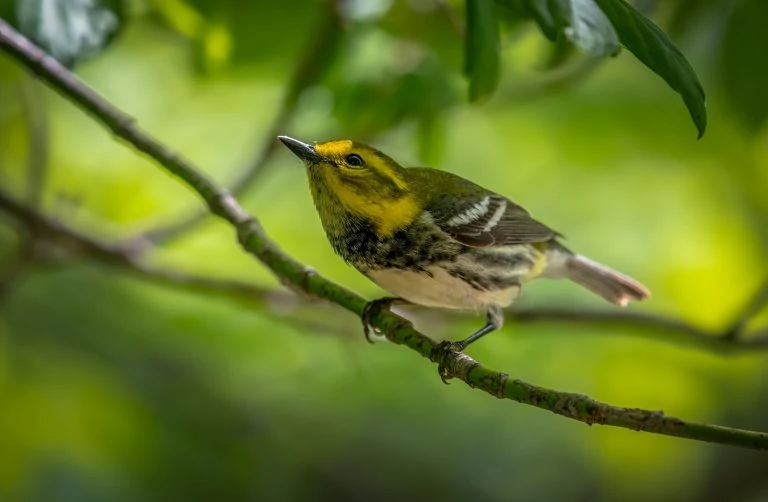
Black-throated Green Warblers live in Nova Scotia during summer and are spotted mainly from mid-April to mid-November. They are recorded in 16% of checklists at this time.
Black-throated Green Warblers are small yellow songbirds with a yellow face and head and olive-yellow back. They have black streaking on the sides and wings and are whitish underneath. Males have large black patches on their throats, but on females and juveniles, this is smaller.
- Setophaga virens
- Length: 4.3-4.7 in (11-12 cm)
- Weight: 0.3-0.4 oz (7-11 g)
- Wingspan: 6.7-7.9 in (17-20 cm)
Black-throated Green Warblers can mostly be seen during their long migration over the eastern US up to their breeding grounds in northeastern US states and Canada. Their winter grounds are in Mexico, northern South America, and the Caribbean.
You can find Black-throated Green Warblers high up in forests eating insects, and their black throat is an easier way to tell them apart from other small yellow birds.
Black-throated Green Warblers song:
Nests of Black-throated Green Warblers are in small trees and close to the truck. The nest is made from twigs and bark woven together with spiders’ webs and lined with animal hair, moss, and feathers. They lay around four eggs, which take twelve days to hatch and an additional ten days for the young to leave the nest.
Attract Black-throated Green Warblers to your backyard with mature trees.
Fun Fact: Male Black-throated Green Warblers can sing over 400 times in an hour and perform a ‘gloating’ flight when they have chased off rivals.
8. Magnolia Warbler
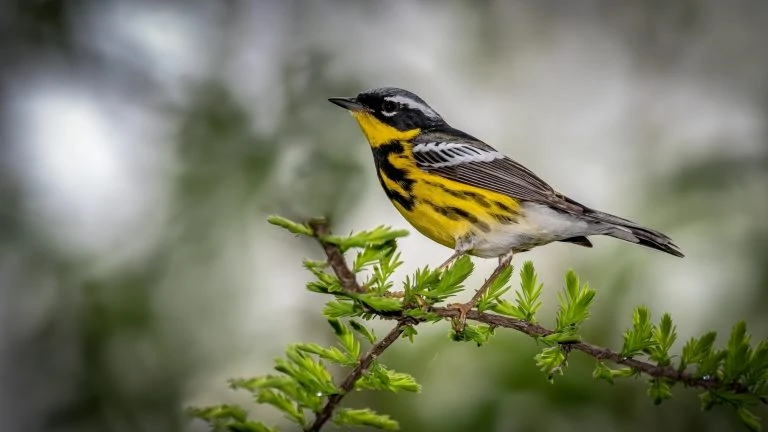
Magnolia Warblers are usually spotted in Nova Scotia from May until October and occur in 14% of summer checklists.
Magnolia Warblers males are black on the back and yellow underneath. They have black streaking forming a ‘necklace’ on their necks and down over their bellies. Females are grayer on the back and lack the distinctive streaking down the belly.
- Setophaga magnolia
- Length: 4.3-5.1 in (11-13 cm)
- Weight: 0.2-0.5 oz (6-15 g)
- Wingspan: 6.3-7.9 in (16-20 cm)
Magnolia Warblers breed across Canada and northeastern US states. They can be seen during migration in the eastern US. They spend the winter in Central America and the Caribbean.
You can find Magnolia Warblers on low branches in forests or parks, so it’s easier to spot them during migration. Their diet is insects and spiders.
Magnolia Warbler song:
Nests of Magnolia Warblers are a loose construction of grass and weeds built close to the trunk of conifer trees. They lay around four eggs that take about twelve days to hatch and a further nine days for the young to leave the nest.
Attract Magnolia Warblers to your backyard with native shrubs and trees for them to rest in during migration.
Fun Fact: Magnolia Warblers show off the white spots on their tails to attract females and to warn off rivals.
9. Palm Warbler
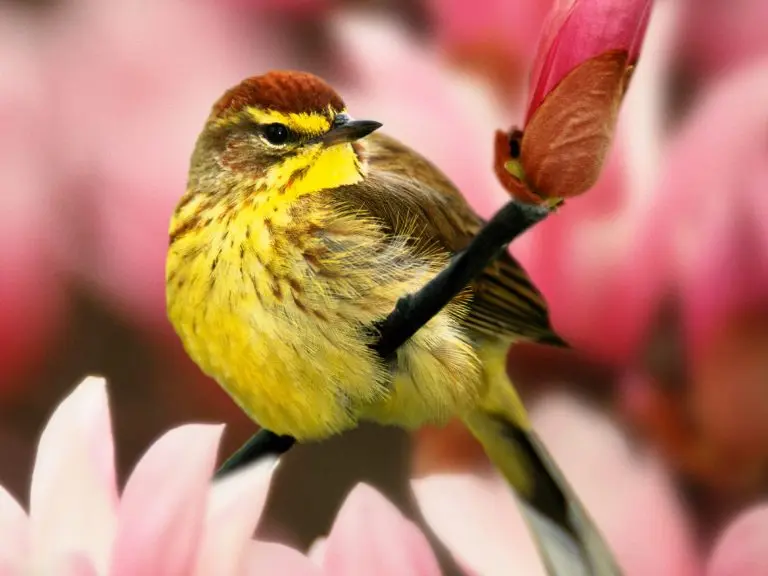
Palm Warblers are spotted in Nova Scotia during summer, but they are more common during spring and fall migration. They appear in 6% of summer checklists and up to 13% of checklists during migration.
The palm warbler has a rusty red patch on the top of its head and is a browny-olive color over the rest of its body. They breed in Canada, but they can be found in eastern states during the migration and all year along the far south coast and Florida.
- Setophaga palmarum
- Length: 4.7-5.5 in (12-14 cm)
- Weight: 0.3-0.5 oz (7-13 g)
- Wingspan: 7.9-8.3 in (20-21 cm)
Palm Warblers breed predominantly in Canada and can be seen during migration in eastern US states. Some winter in Florida and along the southeastern coast.
You can spot Palm Warblers mainly during the spring and fall migration in weedy fields, forest edges, and scrubby areas. They are often found foraging along the ground for insects, mixed in with other birds such as Sparrows, Juncos, and Yellow-rumped Warblers.
Palm Warbler song:
Nests of Palm Warblers are in bogs and boreal forests on the ground and are made from grass, sedge, and ferns woven into a cup shape and lined with soft grass, feathers, and animal hair. They lay around five eggs.
Attract Palm Warblers to your backyard by planting native plants that attract insects and also plant bayberry or hawthorn for their berries.
Fun Fact: Unlike most warblers, Palm Warblers usually walk on the ground bobbing their tails while looking for insects.
10. Evening Grosbeak
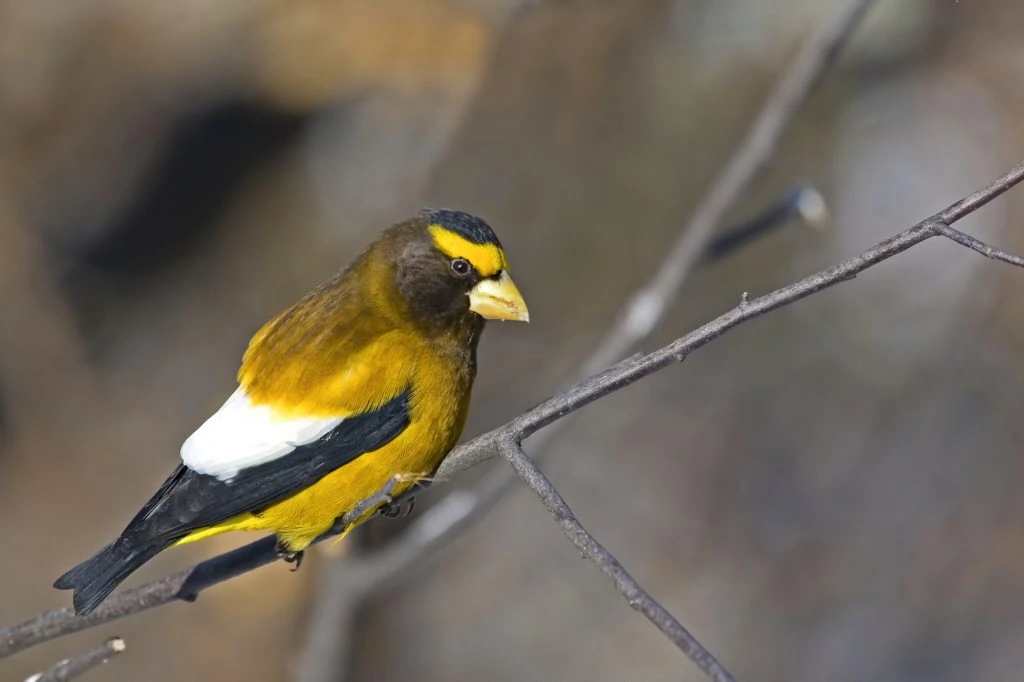
Evening Grosbeaks are vulnerable species in Nova Scotia, but they can be spotted here all year. They occur in 3% of summer and winter checklists.
Evening Grosbeaks are chunky birds with big bills and a striking yellow and black pattern. Adult males have a bright yellow stripe over their eyes, making them look fierce. Their heads are black, with gray necks, and their chest and belly are yellow. They also have a white patch on their wings.
Females and juvenile males have greenish bills, mostly gray bodies, black and white wings, and a yellow tinge to the neck.
- Hesperiphona vespertina
- Length: 16 to 22 cm (6.3 to 8.7 in)
- Weight: 38.7 to 86.1 g (1.37 to 3.04 oz)
- Wingspan: 30 to 36 cm (12 to 14 in)
Evening Grosbeaks remain all year in southern Canada and down the west coast to northern California. However, when cone crops are poor, they will migrate south to most US states.
You can find Evening Grosbeaks in forests and mountain regions. During the winter, they’re often attracted to bird feeders in backyards, most often because it’s an easy food supply.
Evening Grosbeaks naturally feed on flower buds during spring; insect larvae from treetops during the summer; and in the winter, they flock to backyard feeders or feast on seeds, berries, and small fruit.
Evening Grosbeak Song:
Nests of Evening Grosbeaks are usually found up to 100 feet above ground in pine trees. The nests are loosely made, composed of twigs, rootlets, grass, moss, and pine needles. There are usually up to five eggs laid by the female, and she incubates them for two weeks until they hatch.
Attract Evening Grosbeaks to your backyard during winter with sunflower seeds, berries, and maple buds.
Fun Fact: Evening Grosbeaks have such powerful bills that they can crush seeds that are too hard to open for other smaller birds, so these birds hang around to eat whatever is left behind.
11. Nashville Warbler
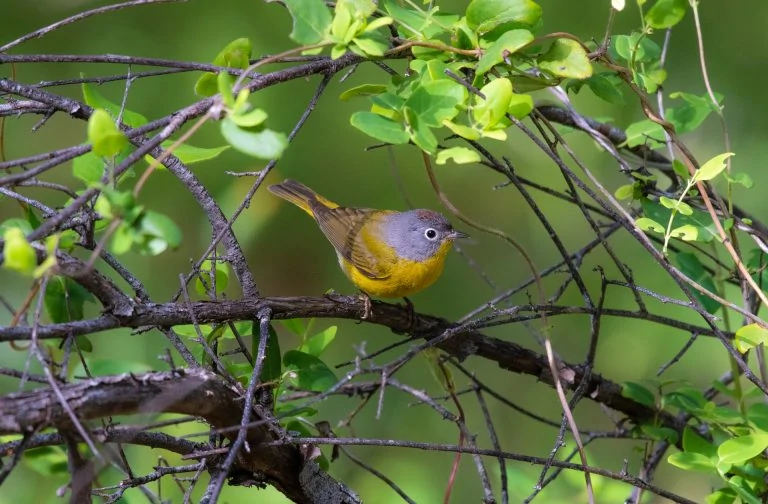
Nashville Warblers are spotted during the breeding season in Nova Scotia and appear in 3% of summer checklists. They arrive in May and start to migrate in November.
Nashville Warblers are mostly yellow underneath but with white lower bellies. They have a greenish yellow back and gray head with a white eyering. Females and juveniles are less bright than males.
- Leiothlypis ruficapilla
- Length: 4.3-5.1 in (11-13 cm)
- Weight: 0.2-0.5 oz (6.7-13.9 g)
- Wingspan: 6.7-7.9 in (17-20 cm)
Nashville Warblers breed in northeastern US states and Canada, and there is a smaller population in northwestern US states and into British Columbia. They can also be seen during migration in most US states. They spend the winter mainly in Mexico.
You can find Nashville Warblers in scrubby habitats and low deciduous forests hunting for insects.
Nashville Warbler song:
Nests of Nashville Warblers are hidden in shrubs close to the ground. The nest is built from bark, grass, and moss woven into a cup lined with softer material. They lay around four eggs which take about twelve days to hatch and ten days for the young to leave the nest.
Attract Nashville Warblers to your backyard in winter in southern US states with suet.
Fun Fact: Nashville Warbles migrate along the Atlantic Coast in their first year but only migrate inland after that.
12. Baltimore Oriole Female
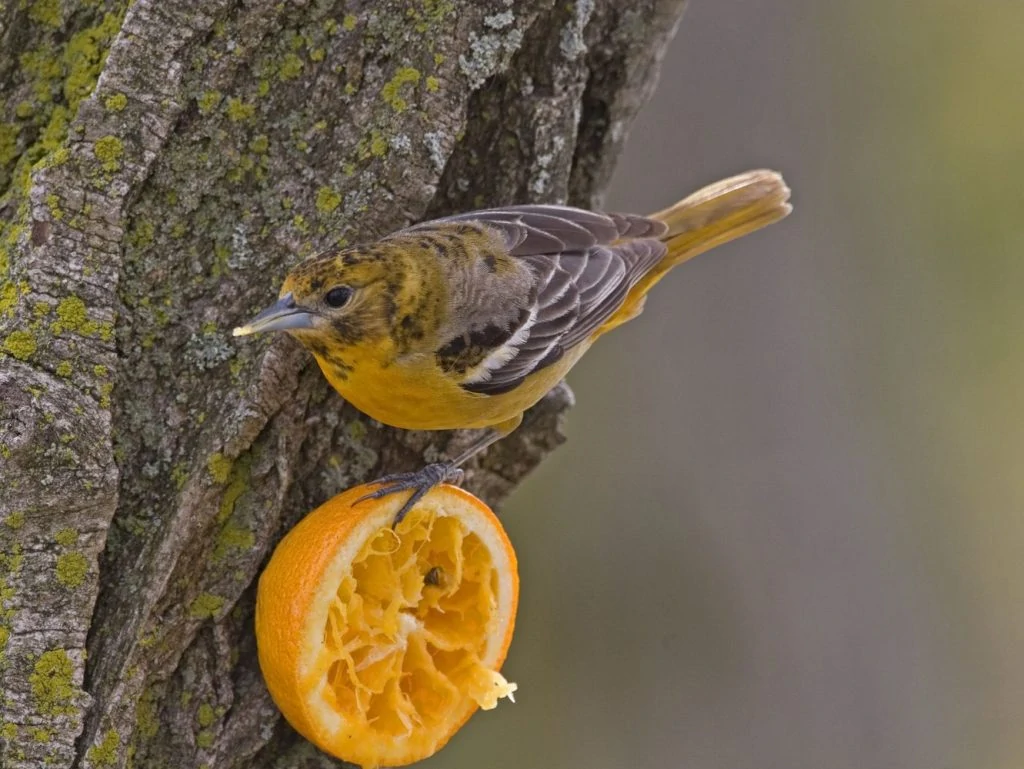
Baltimore Orioles are commonly spotted in Nova Scotia during spring and fall migration, but some also stay for winter.
Baltimore Orioles are a colorful sign of spring in the east of North America. The adult males are bright orange and black with white wing bars on the black wings.
Females are yellowish underneath and on the head and grayish-brown on the wings, their backs or brownish-yellow. They are about the size of a Robin but more slender and are members of the blackbird family.
- Icterus galbula
- Length: 6.7-7.5 in (17-19 cm)
- Weight: 1.1-1.4 oz (30-40 g)
- Wingspan: 9.1-11.8 in (23-30 cm)
Baltimore Orioles breed in Eastern and Central States, including central-southern Canadian provinces and along the southern border with the US.
Baltimore Orioles then migrate to Florida, Central America, and the Caribbean for winter, leaving as early as July.
Baltimore Orioles can be found high up in open woodland, riverbanks, and forest edges foraging for insects and fruit, and they often come to parks and backyards.
Their diet is insects such as beetles, crickets, grasshoppers, spiders, and snails. They also help eat pest species and eat a wide variety of fruits, but they can damage crops such as raspberries, mulberries, cherries, bananas, and oranges.
Baltimore Oriole sounds: The flute-like sound of Baltimore Orioles is one of the joys of spring. They also make chattering and sharp alarm calls.
Attract Baltimore Orioles to your backyard with oranges cut in half on a platform feeder or hanging them from trees. Also, try oriole feeders filled with sugar water. Planting some fruiting plants and nectar plants such as raspberries, crab apples, and trumpet vines should also attract them.
Fun fact: Baltimore Orioles make incredible hanging bag-like nests woven from fibers.
13. Canada Warbler
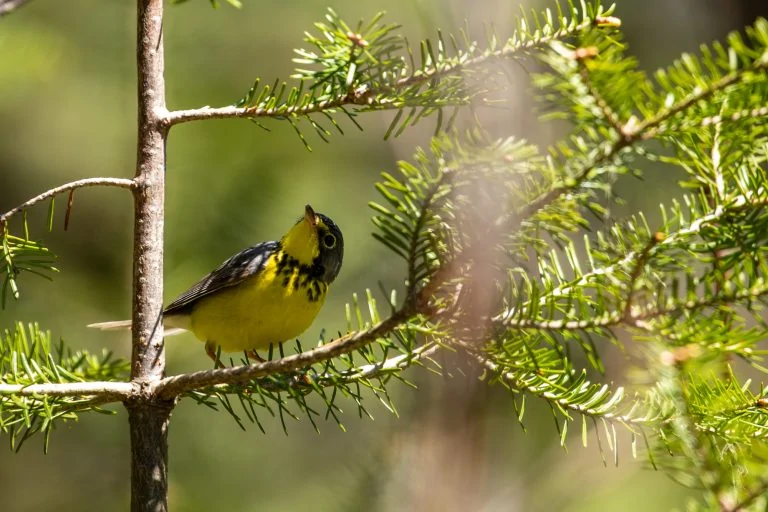
Canada Warblers can be spotted in Nova Scotia from May until October and occur in 1% of summer checklists.
Canada Warblers are similar in appearance to the Magnolia Warbler and have a similar range. However, they are grayish-black on the back, and the black ‘necklace’ in the males, does not extend over the belly, only over the chest. They have yellow chests, bellies, and throats.
Females and immatures are similar but paler on the back and with a less prominent ‘necklace.’
- Cardellina canadensis
- Length: 4.7-5.9 in (12-15 cm)
- Weight: 0.3-0.5 oz (9-13 g)
- Wingspan: 6.7-8.7 in (17-22 cm)
Canada Warblers breed in Canada and northeastern US states, but they can also be seen during migration across the eastern half of the US. They winter in western South America.
You can find Canada Warblers in rhododendron-filled conifer forests or aspen and poplar forests, foraging for insects and spiders. They are difficult to find as their numbers have been declining.
Canada Warbler song:
Nests of Canada Warblers are built near the ground in shrubs or ferns and woven into a cup from grass, bark, leaves, and other plant material. They lay up to six eggs, which take about twelve days to hatch and a further eight days for the young to leave the nest.
Fun Fact: Canada Warblers are flying machines that travel over 3000 miles each way from their winter to summer grounds.
14. Wilson’s Warbler
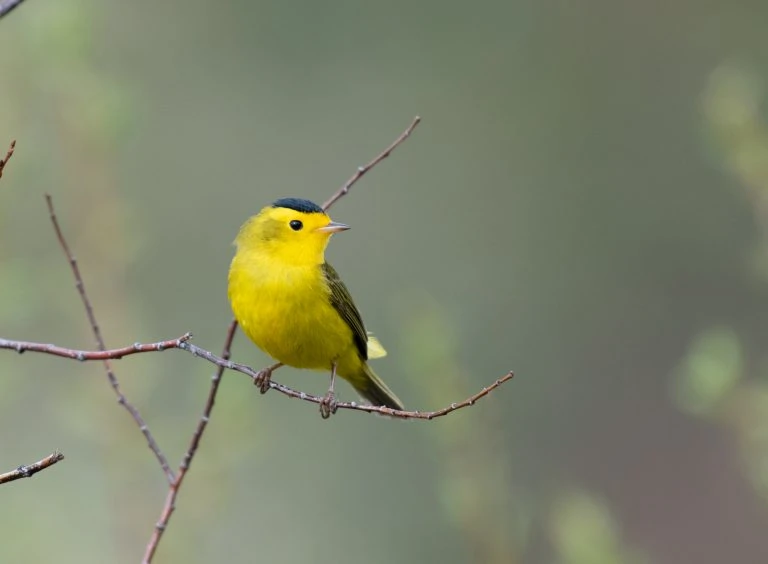
Wilson’s Warblers are usually spotted in Nova Scotia during spring and fall migration.
Wilson’s Warblers are tiny round yellow warblers with a large black cap in the males and a smaller black cap in females.
- Cardellina pusilla
- Length: 3.9-4.7 in (10-12 cm)
- Weight: 0.2-0.3 oz (5-10 g)
- Wingspan: 5.5-6.7 in (14-17 cm)
Wilson’s Warblers breed in Canada, Alaska, and northwestern US states but can also be seen across all US states during migration. They winter in Mexico and Central America.
You can find Wilson’s Warblers along streams in thickets and near forest edges foraging for insects and their larvae and spiders.
Wilson’s Warblers song:
Nests of Wilson’s Warblers are well hidden on the ground near trees or shrubs and made from leaves and sedges for the base. Grass, bark, moss, and plant material are woven into a cup shape and lined with soft grass and animal hair. They lay around five eggs which take about eleven days to hatch and an additional ten days for the young to leave the nest.
Attract Wilson’s Warblers to your backyard with native trees and shrubs, but they do not visit feeders.
Fun Fact: Wilson’s Warblers distract potential nest predators by pretending to have a broken wing and drawing the predator away before flying off.
15. Cape May Warbler
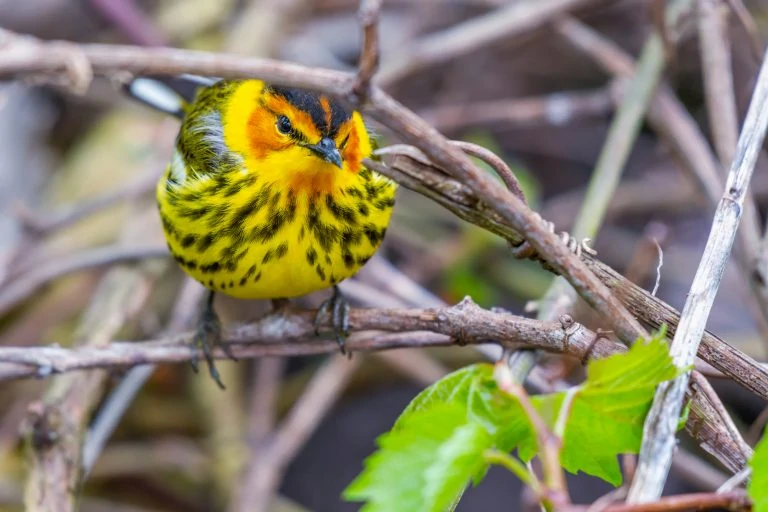
Cape May Warblers are not very common in Nova Scotia, but they can be spotted migrating across the province.
Male Cape May Warblers have distinctive heads with chestnut cheeks, dark caps and are framed in a ring of yellow around the neck. They are mottled yellow-olive above and yellow with dark streaks below.
The tiger stripes on the Cape May Warblers chest and unusual dark crown set this warbler apart from other warblers. Female and immature Cape May Warblers are less bright and lack the head coloring of the males.
- Setophaga tigrina
- Length: 4.7-5.1 in (12-13 cm)
- Weight: 0.4-0.5 oz (10.2-15.2 g)
- Wingspan: 7.9-8.7 in (20-22 cm)
Cape May Warblers migrate to breeding grounds in Canada, passing over eastern US states. They spend the winter in the Caribbean and a narrow band of the coast on the Yucatan Peninsula and Central America.
You can find Cape May Warblers in spruce forests in their breeding grounds. However, during migration, they can be spotted in any habitat, especially near the edges of woods and scrub, where they can find the most insects.
They feed mainly on spruce budworm in summer, but in winter, they will eat fruit and nectar, and they will use hummingbird feeders.
Cape May Warbler song:
Nests of Cape May Warblers are built high up in spruce trees and near the truck. The nest is made from twigs, pine needles, and bark formed into a cup lined with animal hair, feathers, and other soft plant material. They lay up to nine eggs.
Attract Cape May Warblers to your backyard with native shrubs and trees that attract insects, and they may come for fruit and hummingbird feeders.
Fun Fact: Cape May Warblers have specially shaped tongues used for lapping up nectar; it is curled to form a tube shape.
16. Orange-crowned Warbler
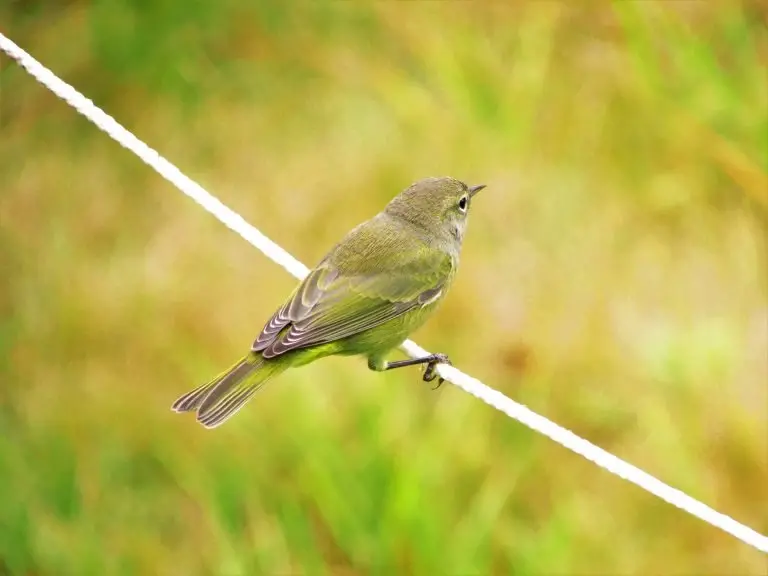
Although not commonly seen here, Orange-crowned Warblers are usually spotted in Nova Scotia during the fall migration, but some also stay until winter. They are usually seen from October to December.
Orange-crowned Warblers are not as brightly colored as other warblers with their yellow-olive coloring, which is more yellow on the Pacific Coast. Their orange crown is rarely seen.
- Leiothlypis celata
- Length: 4.3-5.5 in (11-14 cm)
- Weight: 0.3-0.4 oz (7-11 g)
- Wingspan: 7.5 in (19 cm)
Orange-crowned Warblers breed in Canada and western US states before migrating to the Pacific, East and Gulf Coasts, and Mexico. They can also be seen during migration in all US states, except the northeastern.
You can find Orange-crowned Warblers in shrubs and low vegetation, but they breed in open woodland. Their diet consists mainly of spiders and insects such as caterpillars and flies. They will also eat fruit, berries, and seeds and regularly visit backyard feeders.
Orange-crowned Warbler Song:
Nests of Orange-crowned Warblers are near to or on the ground and made from dead leaves, twigs, and stems and then lined with soft grass and animal hair. They lay up to six eggs.
Attract Orange-crowned Warblers to your yard with suet and peanut butter or hummingbird feeders filled with sugar water nectar.
Fun Fact: Orange-crowned Warblers will drink from the sapwells of sapsuckers and woodpeckers.
17. Eastern Meadowlark
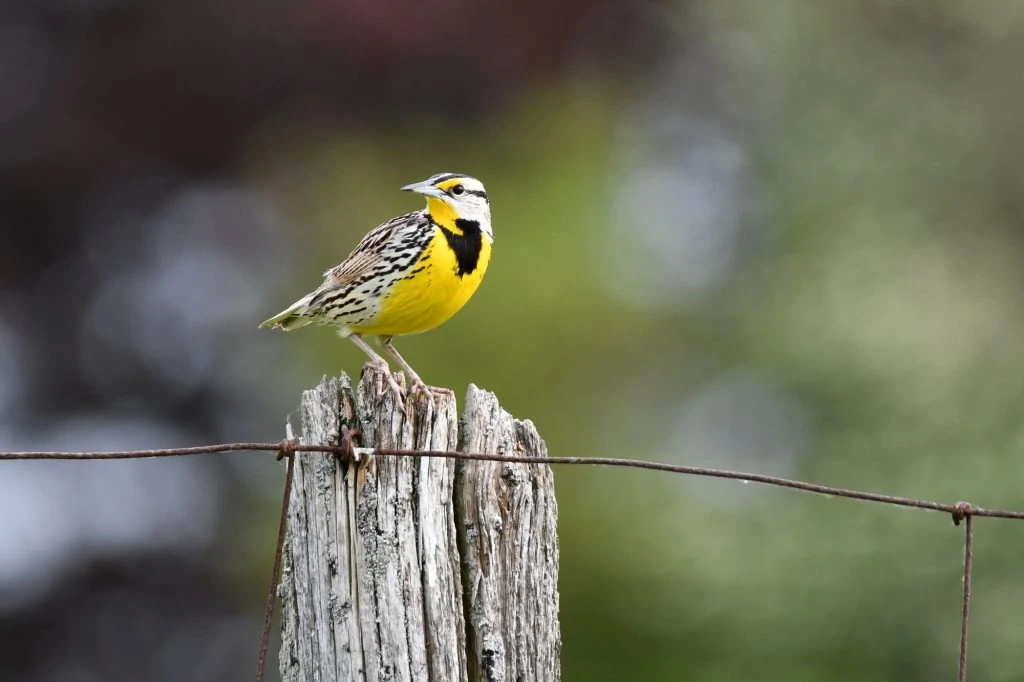
Eastern Meadowlarks are near-threatened species in Nova Scotia, and although they are not often seen here, they have been occasionally spotted in the province all year.
Eastern Meadowlarks are medium-sized songbirds that are bright yellow underneath and pale brown with black marks on the back. They have a distinctive black band across the chest.
- Sturnella magna
- Length: 7.5-10.2 in (19-26 cm)
- Weight: 3.2-5.3 oz (90-150 g)
- Wingspan: 13.8-15.8 in (35-40 cm)
Eastern Meadowlarks are found across eastern US states all year, but they will also breed in the Northeast and Canada before migrating south.
Spring in the East has arrived when the Eastern Meadowlark starts singing and putting on a display, but unfortunately, they are now classed as near-threatened.
You can find Eastern Meadowlarks on the ground in grasslands and prairies, eating insects. They gather in large flocks in fields in winter, looking for seeds.
Eastern Meadowlark sounds: They make flute-like whistles that are clear and melodious.
Nests of Eastern Meadowlarks are on the ground and can be pretty amazing constructions and include tunnels and roofs made of woven grasses.
Fun fact: Eastern Meadowlarks can sing more than 100 songs
How Frequently Yellow Birds are Spotted in Nova Scotia in Summer and Winter
Checklists are a great resource to find out which birds are commonly spotted in your state. These lists show which yellow birds are most frequently recorded on checklists on ebird in summer and winter in Nova Scotia.
Yellow Birds in Nova Scotia in Summer:
American Goldfinch 49.8%
Yellow Warbler 27.2%
Common Yellowthroat 27.2%
Yellow-rumped Warbler 26.6%
American Redstart 18.4%
Black-throated Green Warbler 16.7%
Cedar Waxwing 14.1%
Magnolia Warbler 14.0%
Palm Warbler 6.6%
Nashville Warbler 3.9%
Evening Grosbeak 3.1%
Canada Warbler 1.8%
Baltimore Oriole 1.5%
Wilson’s Warbler 0.9%
Cape May Warbler 0.4%
Orange-crowned Warbler <0.1%
Eastern Meadowlark <0.1%
Yellow Birds in Nova Scotia in Winter:
American Goldfinch 31.8%
Evening Grosbeak 3.8%
Cedar Waxwing 1.8%
Yellow-rumped Warbler 1.4%
Baltimore Oriole 0.5%
Orange-crowned Warbler 0.5%
Palm Warbler 0.2%
Common Yellowthroat 0.1%
Cape May Warbler <0.1%
Wilson’s Warbler <0.1%
Nashville Warbler <0.1%
American Redstart <0.1%
Yellow Warbler <0.1%
Magnolia Warbler <0.1%
Eastern Meadowlark <0.1%
Black-throated Green Warbler <0.1%

